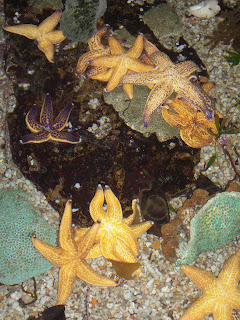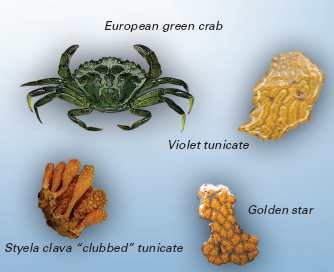 So, in Pt. 1 of the Asterias amurensis, story (here),
So, in Pt. 1 of the Asterias amurensis, story (here), I introduced some general terms and now..some specifics: The Story of an Invasion!
Much of my info is taken from many sources but this awesome 1998 (vol. 15) report
(download as a pdf) are available here from the Centre for Research on Introduced Marine Pests (CRIMP) and includes much basic info on the phenomena. as well as other publications..
Taxonomy Is Important: Identifying the Invader!!
The history of the discovery of this species in Australia actually begins all the way back in
1986 when a bunch of these seemingly unknown starfish were brought into the Tasmanian Museum by a woman who had found them in Rosny, Tasmania.
The folks at the Tasmanian Museum are regional specialists and had made the natural assumption that the starfish they were seeing were morphological varieties of their local species,
Uniophora granifera, which looks like this:
 (image borrowed from Andy & Virg's guide to marine inverts)
(image borrowed from Andy & Virg's guide to marine inverts)
Eventually, the began to see more and MORE of these. The coloration was thought to be part of the natural color variation in Uniophora. But eventually, there were more and more specimens and they realized something was....off. They brought specimens of the animal to the South Australian Museum.
It turned out NOT to be Uniophora, but the North Pacific species, Asterias amurensis!
The invaders had arrived!

This was evidently quite a shock! The news was announced directly via the Australian Broadcasting Channel in 1992 and to quote Elizabeth Turner at the Tasmanian Museum:
"Suddenly all hell broke loose. The media and public could not hear enough about it."
This was unprecedented!! To suddenly have discovered a VERY prominent marine predator in their midst with potential menace to a multi-million dollar aquaculture industry. Plus, these animals occurred in large numbers..so unlike, say tunicates, you could SEE these lovely yellow and purple beauties all over the place.
Reaction & Response

So, all of the various Australian marine organizations got to working! And to make a long story short, the various organizations, such as CSIRO and the Department of Primary Industries and Fisheries had formed the National Seastar Task Force! (on a personal note- I have only seen the words "sea star" -"starfish" and "task force" used together EVER, TWICE. Both times in Australia! AWESOME!)
Information was disseminated! but this was just as the Internet was forming..so we saw Pamphlets! Posters! The word was out!
They organized a "clean up" of
A. amurensis from an area off Prices Wharf in the Hobart area.
This clean up resulted in SIX THOUSAND specimens being collected from a 300 meter stage. Subsequent dives resulted in 24,000 animals killed and piled on the wharf.
I should make sure to note,
this did almost NOTHING to the population !!!
What do you do with 30,0000 dead starfish?? These were sent off to composting by the University of Tasmania!
So Where Did They Come From???
Funding started to flow towards various universities and labs to get data on the introduced pest. So, the invaders had arrived via ballast water on ships-but from WHERE??

Early allozyme work using genetic distances (different from today's population genetics using gene data) narrowed down the populations from Tasmania as being most similar to populations in Japan (near Tokyo and Suruga).
Repel the Invasion??

Various methods of minimizing the impact of this species have been developed, considered, and studied over the years. Some are used today and others were not. This includes:
1. Using DNA "fingerprinting" to recognize the larvae from ballast water.
Such as in this paper. 2. Various poisons,
2. Various poisons, such as the classic anti-starfish measure
quicklime, formalin, ammonia, copper sulfate, and even reproductive inhibitors!! The list goes on. Unfortunately all seem to be just as harmful to humans. So, not ideal and let's say...NOT a primary strategy.
 3. Natural Control.
3. Natural Control. There are ciliates that
parasitize and can castrate sea stars in the North Pacific. This was considered...but using introduced species Vs. introduced species is usually a way to exponentially INCREASE your problems. Its not clear that these could distinguish between
A. amurensis and Australian species. So..uh...maybe not.
4. ....and the old standby, physical removal! Simply put-pullin' them off and throwin them up on the pier.

Interestingly, there was also a discussion of using
A. amurensis in "commercial harvesting".

Apparently, they cost $1.00 USD in China for FOOD. ugh...(allegedly they are tasty steamed-yuck) They concluded there was NO market for human consumption.
Good call.
What has been the Impact??
So, its now 2009 and its been
23 years since
A. amurensis has been in Australia! What has changed???
1. Range Extension. A. amurensis has SPREAD from Tasmania to the southern part of Australia! New Zealand is on alert...
 2. The Impact on Soft-bottom communities.
A lot of ecological work has been funded since A. amurensis has taken hold. A lot of this work has been done by Dr. Jeff Ross at the University of Tasmania.
A list of his publications is here.
2. The Impact on Soft-bottom communities.
A lot of ecological work has been funded since A. amurensis has taken hold. A lot of this work has been done by Dr. Jeff Ross at the University of Tasmania.
A list of his publications is here.
They eat a variety of bivalves, including the commercial bivalve
Fulvia tenuicostata, various snails, and the sea urchin
Echinocardium cordatum, changing the abundance of these animals and the long-term ecology of soft bottoms.

The Carcinus-Asterias ONE-TWO PUNCH! Also, it turns out there's MORE then one big introduced predator in Australian waters!
 There is apparently competition between these crabs and Asterias in the feeding of these beasts on bivalves.
There is apparently competition between these crabs and Asterias in the feeding of these beasts on bivalves.  Asterias amurensis
Asterias amurensis apparently feeds on the BIG bivalve prey VERSUS the crab,
Carcinus maenas which feeds on the small ones!! Consider this as there's more and MORE of these and as the two species begin to impact all of the bivalves in the region.
yow.
So, what's the lesson here? Hmmm... Introduced species-BAD.
In contrast an invasion of starfish from space seems kind of welcome...

 From Wed. July 29-The Australian Broadcasting Company...here.
From Wed. July 29-The Australian Broadcasting Company...here.













































